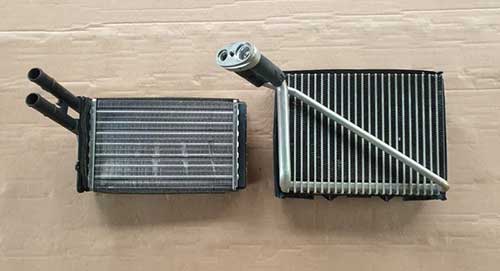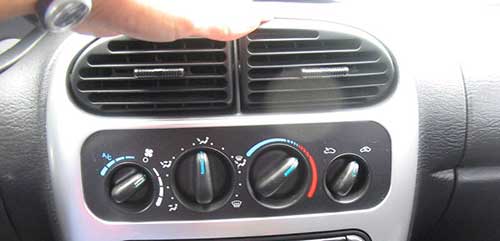When cold season arrives, the car heater suddenly becomes a very important car part that is used almost always as you drive. A warm and cozy cabin is always a good idea that protects you from the autumn and winter weather.
But, sometimes the car heater does not warm the cabin enough or does not work at all blowing only cold air, especially when idle. This aspect is not beneficial for the windows because they can be easily steamed.
To better understand the problems and bad symptoms with the car heater, we need to get acquainted with the entire heating system.
For the heater to work properly and without failures, all its spare parts must be in good condition. It is arranged quite simply and consists of a radiator itself, a special device for regulating the movement of the liquid, pipes through which the cooling liquid circulates, air ducts.
The car’s heating system also includes a fan. The heater will work if there are no failures in each separate part of it.

Contents
Why is the car heater not working properly?
- The heating system will not work properly if air enters it when the coolant is replaced. So be careful when replacing the coolant.
- Air can enter the heating system if there is damage to the main cylinder block.
- The thermostat could be jammed in the open position. If you are going fast enough, the heater can not cope with heating, and at low speeds, it warms well, if that’s so, then most likely this is the problem.
- Also, the heating-cooling system can not work 100% if the radiator of the heater is clogged. This can happen for several reasons. Insects, leaves, and dust get into the radiator. Or sealant may have entered the radiator. There will be a problem if water or poor-quality coolant gets into the heater’s radiator. We will talk in detail in another article about how to wash the heater’s radiator
- The cabin filter can also lead to failures in heating if it hasn’t been changed for some time, is clogged or filled with dust and debris.
- A frequent cause is the failure of the fan itself. Bearings or brushes may fail, causing the entire system to malfunction. There may also be problems directly related to electronics.
- Sometimes, the heating system fails due to damage to the radiator flap. Air may not enter the system, or it may not enter in a sufficient amount. Thus, a poorly working radiator flap and air vents are often the cause of the poor performance of the heater.
- A broken heater pipe. In very rare cases, depending on the car model, due to its location in the car, it is very easy to accidentally hit this pipe. It breaks down and is completely unusable. It should be replaced with a new one, after which the operation of the stove should be normalized.
- A bad or failing heater control unit, the heater controller, could have failed. This will be noticeable if the fan does not work well in positions 1 and 2 or does not turn on at all. Replacing the heater control unit is not so expensive, but most of the time you will have to replace the entire control unit.
- A faulty air temperature sensor may cause the heating system to malfunction.

Checking the above causes in the early stage can help you stay away from spending a lot of money for repairs.

How to maintain the car heater?
- It is necessary to regularly clean the radiators to prevent various types of problems. The external radiator can be cleaned with compressed air streams and, if necessary, can be removed and washed under running water. The internal radiator can also be cleaned with a vacuum cleaner if the level of contamination is not very high.
- When using an aftermarket or just not quite high-quality coolant, build-ups inside the channels of the pipes cannot be avoided. You can easily clean the radiator without removing it. You just need to swap the top and bottom pipes and let the car run a little. You can also clean it with household citric acid or use a special flushing liquid. To avoid this problem, it is recommended to change the coolant at least once every two years.
- A faulty thermostat must be replaced as soon as possible. In fact, I would not recommend at all driving with a bad thermostat. If it is stuck open, then the heater will not be able to fully warm up the cabin, and the engine itself will take longer to warm up. If the thermostat is stuck open, then this can lead to engine overheating, which means the engine could fail, or it will require high costs for repairs.
- If the air from the heater is hot, but its flow is very weak, then the cabin filter is most likely clogged. It is not recommended to use a car without a cabin filter, as all dust, microbes, leaves, and debris from the road will get directly into the cabin. Therefore, the filter should be replaced with a new one.
- The heating system will not work well if there are air bubbles in it. This is not a big problem, it can be solved. First, you should try to expel the air with the engine off. Open the cap of the coolant reservoir, find the hose from the reservoir to the radiator and try to pour antifreeze by hand. If this method is not working, then it is necessary to let the car idle.
- You also need to pay attention to the control levers of the heater itself. If the cable or heater valve has come off, this may be the reason for the poor operation of the entire system.
- The bearings on the heater fan should be periodically lubricated, and also cleaned of dust.
If at an outside air temperature is, let’s say, -25 degrees C (-13 F), the heater warms up the cabin up to +16 degrees C (61 F) from the bottom and +10 degrees C from the top (50 F), the heater can be considered quite serviceable. In this case, the temperature in the rear seats of the car should be approximately +15 degrees C (59 F). The presence of such a noticeable difference between the temperature at the bottom of the cabin and the temperature at the top will provide a comfortable ride for both the driver and the passengers.
To avoid such problems, it is recommended to carry out all preventive measures on time and carefully. This will allow you to enjoy a ride in a well-warmed car. You will protect the windows from the frozen layer or steam, making your journey safer. The more you drive the car, the more attention its heating system requires. This applies to all vehicles.
